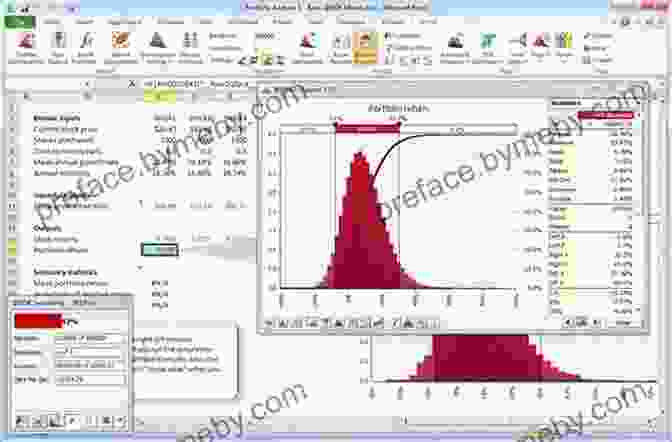Harness the Power of Monte Carlo Simulation with Excel: A Comprehensive Guide

Unlock the Secrets of Probabilistic Modeling with Practical Monte Carlo Simulation With Excel

In the ever-evolving technological landscape, the need for accurate and efficient data analysis has become paramount. Among the many powerful techniques available, Monte Carlo simulation stands out as a versatile tool for probabilistic modeling and risk assessment. This comprehensive article aims to introduce you to the fascinating world of Monte Carlo simulation, specifically focusing on its practical implementation using Microsoft Excel.
4.5 out of 5
| Language | : | English |
| File size | : | 19191 KB |
| Text-to-Speech | : | Enabled |
| Screen Reader | : | Supported |
| Enhanced typesetting | : | Enabled |
| Word Wise | : | Enabled |
| Print length | : | 216 pages |
| Lending | : | Enabled |
Understanding Monte Carlo Simulation: A Foundational Overview
Monte Carlo simulation, named after the famous casino in Monaco, is a powerful technique that relies on repeated random sampling to calculate probabilistic outcomes. It simulates thousands or even millions of possible scenarios, providing insights into the likelihood of various outcomes and helping decision-makers evaluate potential risks and opportunities.
The key concept behind Monte Carlo simulation lies in the law of large numbers, which states that as the number of trials approaches infinity, the average of the outcomes will converge to the expected value of the underlying probability distribution. By simulating a large number of trials, Monte Carlo methods provide an approximation of the true probability distribution of the outcome.
Delving into Practical Monte Carlo Simulation with Excel
Microsoft Excel, the ubiquitous spreadsheet software, offers robust capabilities for performing Monte Carlo simulations. Its user-friendly interface and versatile functions make it an ideal platform for both beginners and experienced modelers alike.
1. Setting Up the Simulation Framework
To embark on your Monte Carlo simulation in Excel, begin by creating a spreadsheet that defines the input parameters, probability distributions, and the formula for calculating the desired output. Input parameters represent the uncertain factors that influence the outcome, while probability distributions describe the likelihood of each possible value for those parameters.
For instance, consider simulating the sales forecast for a new product. Input parameters could include market demand, sales conversion rate, and production costs, each with their respective probability distributions. The formula for calculating the output would then incorporate these parameters to estimate sales revenue.
2. Generating Random Inputs
The heart of Monte Carlo simulation lies in generating random numbers that follow the specified probability distributions. Excel provides several functions for this purpose, such as RANDBETWEEN() and NORMINV(),which generate random numbers from uniform and normal distributions, respectively.
By using these functions, you can populate a range of cells with random values that represent the input parameters. This step is crucial to ensure that the simulation accurately captures the uncertainties inherent in the problem.
3. Iterating the Simulation
With the inputs generated, the simulation proceeds by iteratively calculating the output for each set of input values. Excel's强大功能,如数组公式和数据透视表,可以极大地简化这一过程。
For example, you could use an array formula to simultaneously calculate sales revenue for each row of randomly generated input values. By repeating this process for a sufficient number of iterations (e.g., 10,000 or more),you will accumulate a large sample of possible outcomes.
4. Analyzing the Simulation Results
Once the simulation has run its course, the next step involves analyzing the results to gain insights into the probabilistic behavior of the modeled system. Excel's богатый набор инструментов для анализа данных, таких as histograms, scatterplots, and summary statistics, facilitate this process.
By examining the distribution of the simulated outputs, you can identify the most likely outcomes, assess the range of possible values, and quantify the risks associated with different scenarios. This information empowers decision-makers to make informed choices based on the probabilities and uncertainties involved.
Case Study: Simulating Project Completion Time with Excel
To illustrate the practical applications of Monte Carlo simulation with Excel, let's consider a case study involving the estimation of project completion time. Project managers often face uncertainties in factors such as resource availability, technical challenges, and external dependencies.
Using Monte Carlo simulation in Excel, we can incorporate these uncertainties by assigning probability distributions to each factor. For instance, resource availability could be modeled with a normal distribution, while technical challenges and external dependencies could be represented by triangular distributions.
By simulating thousands of iterations, we can generate a probability distribution of possible project completion times. This distribution provides valuable insights into the likelihood of completing the project within a specific deadline, enabling project managers to plan and mitigate risks accordingly.
: Unlocking the Value of Monte Carlo Simulation with Excel
Monte Carlo simulation has emerged as a powerful tool for probabilistic modeling and risk assessment in a wide range of fields, from finance to healthcare to project management. By harnessing the capabilities of Microsoft Excel, individuals can easily perform complex Monte Carlo simulations and gain valuable insights into the uncertainties and potential outcomes of their systems and decisions.
This comprehensive article has provided an overview of the principles and practical implementation of Monte Carlo simulation with Excel. By embracing this technique, you can unlock the potential for probabilistic modeling, enhance your data analysis, and make informed decisions in the face of uncertainty.
Additional Resources:
* [Monte Carlo Simulation in Excel: A Beginner's Guide](https://www.excel-easy.com/data-analysis/monte-carlo-simulation-in-excel.html) * [Using Monte Carlo Simulation for Project Risk Analysis](https://www.projectmanagement.com/articles/466686/Using-Monte-Carlo-Simulation-for-Project-Risk-Analysis) * [Excel Monte Carlo Simulation Template](https://www.vertex42.com/ExcelTemplates/monte-carlo-simulation.html)
4.5 out of 5
| Language | : | English |
| File size | : | 19191 KB |
| Text-to-Speech | : | Enabled |
| Screen Reader | : | Supported |
| Enhanced typesetting | : | Enabled |
| Word Wise | : | Enabled |
| Print length | : | 216 pages |
| Lending | : | Enabled |
Do you want to contribute by writing guest posts on this blog?
Please contact us and send us a resume of previous articles that you have written.
 Book
Book Novel
Novel Page
Page Chapter
Chapter Text
Text Story
Story Genre
Genre Reader
Reader Library
Library Paperback
Paperback E-book
E-book Magazine
Magazine Newspaper
Newspaper Paragraph
Paragraph Sentence
Sentence Bookmark
Bookmark Shelf
Shelf Glossary
Glossary Bibliography
Bibliography Foreword
Foreword Preface
Preface Synopsis
Synopsis Annotation
Annotation Footnote
Footnote Manuscript
Manuscript Scroll
Scroll Codex
Codex Tome
Tome Bestseller
Bestseller Classics
Classics Library card
Library card Narrative
Narrative Biography
Biography Autobiography
Autobiography Memoir
Memoir Reference
Reference Encyclopedia
Encyclopedia Emily A Benson
Emily A Benson Sukhveer Singh
Sukhveer Singh Lori Walburg
Lori Walburg Emily Raij
Emily Raij Kaleena Amuchastegui
Kaleena Amuchastegui Enoch Leffingwell
Enoch Leffingwell Elizabeth L Eisenstein
Elizabeth L Eisenstein Lesley Bown
Lesley Bown James Scott Bell
James Scott Bell Joe Simpson
Joe Simpson Eli J Knapp
Eli J Knapp Robert Sberna
Robert Sberna John Naisbitt
John Naisbitt Michele Stanten
Michele Stanten Steven R Weisman
Steven R Weisman Steve Swink
Steve Swink Laurence J Kotlikoff
Laurence J Kotlikoff Steven M Barrett
Steven M Barrett Kenneth P Stephens
Kenneth P Stephens Eleanor Roosevelt
Eleanor Roosevelt
Light bulbAdvertise smarter! Our strategic ad space ensures maximum exposure. Reserve your spot today!

 Nathaniel HawthorneRedefine Resilience: A Comprehensive Guide to Refueling, Recharging, and...
Nathaniel HawthorneRedefine Resilience: A Comprehensive Guide to Refueling, Recharging, and...
 David BaldacciGendered Identity and Aspiration on the Globalized Shop Floor: A Journey of...
David BaldacciGendered Identity and Aspiration on the Globalized Shop Floor: A Journey of... Chris ColemanFollow ·19.7k
Chris ColemanFollow ·19.7k Owen SimmonsFollow ·18.2k
Owen SimmonsFollow ·18.2k Jerome BlairFollow ·18.8k
Jerome BlairFollow ·18.8k Nathaniel HawthorneFollow ·9.4k
Nathaniel HawthorneFollow ·9.4k Alexander BlairFollow ·16.8k
Alexander BlairFollow ·16.8k Howard BlairFollow ·16.9k
Howard BlairFollow ·16.9k Branden SimmonsFollow ·13.4k
Branden SimmonsFollow ·13.4k Isaiah PriceFollow ·2k
Isaiah PriceFollow ·2k

 Richard Adams
Richard AdamsGame Development with Rust and WebAssembly: A...
Are you passionate...

 David Baldacci
David BaldacciGendered Identity and Aspiration on the Globalized Shop...
: The Convergence of Gender, Identity, and...

 Natsume Sōseki
Natsume SōsekiFresh Eyes On Panama: A Captivating Exploration of a...
Panama, a country often overshadowed by its...

 Adrian Ward
Adrian WardThe Life and Masterworks of J.M.W. Turner: A Timeless...
The Man Behind the Masterpieces ...
4.5 out of 5
| Language | : | English |
| File size | : | 19191 KB |
| Text-to-Speech | : | Enabled |
| Screen Reader | : | Supported |
| Enhanced typesetting | : | Enabled |
| Word Wise | : | Enabled |
| Print length | : | 216 pages |
| Lending | : | Enabled |












